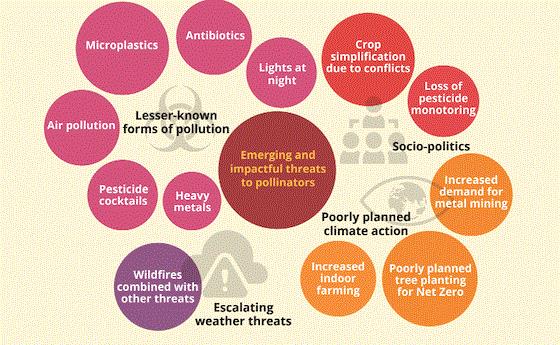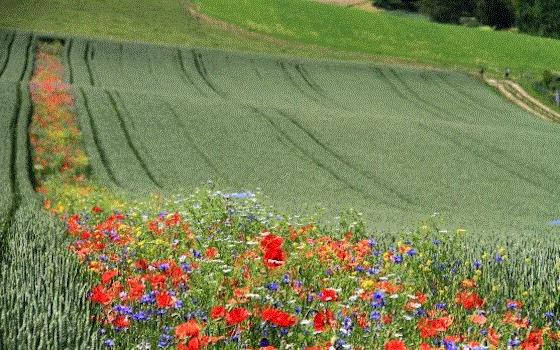Report Identifies New Threats to Bees—Including CEA?
A new global campaign to save pollinators, called Bee:wild, just released their report on “Emerging Threats and Opportunities for Conservation of Global Pollinators.” In it, they identify the top 12 emerging threats that “could accelerate pollinator losses within the next 5-15 years, according to ten of the world’s leading experts.”
Continued threats:
-
Habitat loss
-
Pesticides
-
Climate change altering habitats, flowering times and pollinator activity
-
Pests and pathogens
-
Invasive species
New and emerging threats:
-
Lesser-known forms of pollution, including microplastics, antibiotics, air pollution heavy metals, and artificial light at night
-
Poorly planned climate action (especially things that impact habitat)
-
Socio-political effects on the environment
-
Escalating weather threats (ex. wildfires)

Of note is that they called out indoor agriculture as being a potential threat. The authors suggest, “Growing crops in enclosed spaces reduces natural habitats for wild pollinators and may spread disease through the introduction of managed pollinators.”
If you want to dig into any of this, there’s a full report
HERE. For the shorter executive summary, go
HERE.

New Bioinsecticide Available from BioWorks
BioWorks just launched
Principle WP, a bioinsecticide with
Beauveria bassiana as the active ingredient.
 It’s labeled for thrips, aphids, whiteflies, beetles, caterpillars, crickets, grasshoppers, leafhoppers, planthoppers, flies, mealybugs, plant bugs and psyllids. The mode of action is penetration and infection of the target pest cuticle, which is said to reduce the risk of insecticide resistance to zero. The label allows for use on vegetables, nursery crops, ornamentals, fruits, vines, hemp and more.
It’s labeled for thrips, aphids, whiteflies, beetles, caterpillars, crickets, grasshoppers, leafhoppers, planthoppers, flies, mealybugs, plant bugs and psyllids. The mode of action is penetration and infection of the target pest cuticle, which is said to reduce the risk of insecticide resistance to zero. The label allows for use on vegetables, nursery crops, ornamentals, fruits, vines, hemp and more.
BioWorks notes that Principle WP has remarkably low residue, and this proprietary formulation is labeled for both indoor and outdoor use. You can use it as a foliar spray, soil drench, dipping, and in aerial applications. It’s also considered to have an excellent compatibility with both conventional pesticides and other biologicals.
Other important details: it has a 4-hour REI, 0-day PHI, and is exempt from residue tolerance. Plus, it is OMRI listed!
Flower Strip Pest Control
Flower strips—areas of land planted with a variety of flowering plants—have proved useful in (or alongside) ag fields, attracting natural enemies that can keep pest levels down. A new meta-analysis from the University of Copenhagen says that those flower strips are indeed effective, but only if they have two or more flower species. The more species, the more natural enemies in the field.
 Photo: Agroscope
Photo: Agroscope
The benefits of biodiversity seemed clear: Flower strips with just two species increased natural enemies by an average of 70%, compared to having no flowers at all. For each flower species added to the planting mix, natural enemies increased by an average of 4.1%.
What flowers performed well? Yarrow, ox-eye daisy and bellis were some of the top picks.
Gardening’s Bright Light
The
Garden Media Group released a spring report earlier in May: “Garden Pulse: Spring 2025 Analysis.” According to their data, gardening is holding strong even while other retail industries are seeing some consumers hitting pause.
In a press release, Katie Dubow, president of Garden Media Group, said, “Gardening has always been recession-resistant. In 2008, 2020, and now again in 2025, we’re seeing a familiar pattern. When people face financial or emotional uncertainty, they return to their roots—literally.”
Sales at independent garden centers (at the time of the report) were 3.9% behind 2024, but up 27% from 2020. Interestingly, the National Wildlife Federation reports that wildlife garden certifications are up 12% over last year. And the chatter about gardening on social media is growing significantly.
Sid Raisch of Horticultural Advantage and the Garden Center Group offered this nugget of wisdom on championing real-life sustainability: “Be the local, sustainable alternative to chain stores and imported goods. Promote growing healthy food without chemicals or heavy shipping costs. Inspire families to swap screen time for green time—building gardens together, learning real-life skills, and reconnecting with nature and each other. Gardening offers not just food, but wellness, resilience and self-reliance.”
Get the full report
HERE.

Report from the MT Outpost

I’m going to piggy-back right off that report from the Garden Media Group because I’ve been a walking, talking, gardening example of their advice on “highlighting the value of staying home, digging in, and investing in wellness through plants.” We had stunning weather for the holiday weekend, and I was feeling pretty ragged. Instead of taking off on an adventure, I stayed home to work in the gardens (and unfortunately, also on the computer) while making time for garden work. I bought "all" the plants, and this year, instead of stressing about everything I need to do in the garden, I’m treating each chore as a mini therapy session—a chance to get away from the chaos and get my hands dirty for an hour at a time.
Meanwhile, we’re nearing completion of our guest cabin next door, and I’m adamant that we’re not going to make the same mistake so many new builds around here make—whereby they run out of time and money before they get to the landscaping. I sympathize that it’s tough in this hot/dry summer framed by long-cold-winters climate with herds of hungry ungulates to get invested in flowers and shrubs and such. But I’m doing it. I installed one giant perennial bed at the cabin last week, and a landscaper friend will be doing some major hardscaping in the backyard with boulders we already have on the property. Fortunately, I have seven years’ worth of data of what the deer will and won’t eat around here.
Here’s my theory: one of the keys to the vacation rental market these days is experiential marketing. People want a specific experience, an invitation to engage, a story. I am betting that a well-landscaped cabin (up here, I’m going for a kind of wild, native perennial vibe) does more to create atmosphere and a sense of place in this vast landscape than a fancy couch. (I still got the fancy couch …) Let’s see how it goes.




Until next time,

Jennifer Duffield White
jwhite@ballpublishing.com
This email received by 27,122 loyal readers!
Want to be one of the lucky sponsors who reach those readers of GreenTalks? Drop Paul Black a line and he’ll tell you what a bargain it is!
GreenTalks® is a registered trademark of Ball Horticultural Company in the U.S.